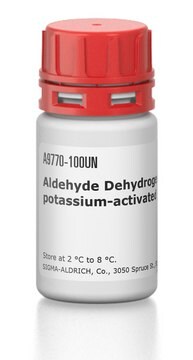A3263
Alcohol Dehydrogenase from Saccharomyces cerevisiae
powder, ≥300 units/mg protein, mol wt ~141,000 (four subunits)
Sinonimo/i:
ADH1, ADH, Alcohol Dehydrogenase from yeast, Alcohol:NAD+ oxidoreductase
About This Item
Origine biologica
bakers yeast
Forma fisica
powder
Attività specifica
≥300 units/mg protein
PM
~141,000 (four subunits)
Purificato mediante
crystallization
Condizioni di stoccaggio
(Tightly closed. Dry)
Caratteristiche più verdi
Waste Prevention
Design for Energy Efficiency
Learn more about the Principles of Green Chemistry.
sustainability
Greener Alternative Product
Colore
beige
pH ottimale
8.6-9.0
Compatibilità
suitable for recycling micro-assay of β-NAD and β-NADH
N° accesso UniProt
Categoria alternativa più verde
Temperatura di conservazione
−20°C
Cerchi prodotti simili? Visita Guida al confronto tra prodotti
Descrizione generale
Yeast alcohol dehydrogenase 1 (ADH1) belongs to the family of zinc-containing alcohol dehydrogenases. It is a homotetramer with each subunit containing one catalytic domain and coenzyme-binding domain.
We are committed to bringing you Greener Alternative Products, which adhere to one or more of The 12 Principles of Greener Chemistry. This product has been enhanced for energy efficiency and waste prevention when used in fuel cell research. For more information see the article in biofiles.
Applicazioni
Azioni biochim/fisiol
Isoelectric point: 5.4-5.8
Optimal pH: 8.6-9.0
Substrates: Yeast ADH is most active with ethanol and its activity decreases as the size of the alcohol increases or decreases. Branched chain alcohols and secondary alcohols also have very low activity.
KM (ethanol) = 2.1 × 10-2 M
KM (methanol = 1.3 × 10-1 M
KM (isopropanol) = 1.4 × 10-1 M
Inhibitors: Compounds that react with free sulfhydryls, including N-alkylmaleimides and iodoacetamide.
Zinc chelator inhibitors, including 1,10-phenanthroline,
8-hydroxyquinoline, 2,2′-dipyridyl, and thiourea.
Substrate analogue inhibitors, including β-NAD analogs, purine and pyrimidine derivatives, chloroethanol, and fluoroethanol.
Extinction Coefficient: E1% = 14.6 (water, 280 nm)
Specifiche
Definizione di unità
Stato fisico
Anticorpo
Avvertenze
Danger
Indicazioni di pericolo
Consigli di prudenza
Classi di pericolo
Resp. Sens. 1
Codice della classe di stoccaggio
11 - Combustible Solids
Classe di pericolosità dell'acqua (WGK)
WGK 1
Punto d’infiammabilità (°F)
Not applicable
Punto d’infiammabilità (°C)
Not applicable
Dispositivi di protezione individuale
Eyeshields, Gloves, type N95 (US)
Certificati d'analisi (COA)
Cerca il Certificati d'analisi (COA) digitando il numero di lotto/batch corrispondente. I numeri di lotto o di batch sono stampati sull'etichetta dei prodotti dopo la parola ‘Lotto’ o ‘Batch’.
Possiedi già questo prodotto?
I documenti relativi ai prodotti acquistati recentemente sono disponibili nell’Archivio dei documenti.
I clienti hanno visto anche
Protocolli
This procedure may be used for Alcohol Dehydrogenase products.
Il team dei nostri ricercatori vanta grande esperienza in tutte le aree della ricerca quali Life Science, scienza dei materiali, sintesi chimica, cromatografia, discipline analitiche, ecc..
Contatta l'Assistenza Tecnica.


